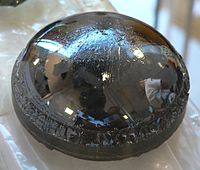
Photo from wikipedia
Cubic silicon carbide (3C-SiC) offers an alternative wide bandgap semiconductor to conventional materials such as hexagonal silicon carbide (4H-SiC) or gallium nitride (GaN) for the detection of UV light and… Click to show full abstract
Cubic silicon carbide (3C-SiC) offers an alternative wide bandgap semiconductor to conventional materials such as hexagonal silicon carbide (4H-SiC) or gallium nitride (GaN) for the detection of UV light and can offer a closely lattice matched virtual substrate for subsequent GaN heteroepitaxy. As 3C-SiC can be heteroepitaxially grown on silicon (Si) substrates its optical properties can be manipulated by controlling the thickness and doping concentrations. The optical properties of 3C-SiC epilayers have been characterized by measuring the transmission of light through suspended membranes. Decreasing the thickness of the 3C-SiC epilayers is shown to shift the absorbance edge to lower wavelengths, a result of the indirect bandgap nature of silicon carbide. This property, among others, can be exploited to fabricate very low-cost, tuneable 3C-SiC based UV photodetectors. This study investigates the effect of thickness and doping concentration on the optical properties of 3C-SiC epilayers grown at low temperatures by a standard Si based growth process. The results demonstrate the potential photonic applications of 3C-SiC and its heterogeneous integration into the Si industry.
Journal Title: Semiconductor Science and Technology
Year Published: 2017
Link to full text (if available)
Share on Social Media: Sign Up to like & get
recommendations!